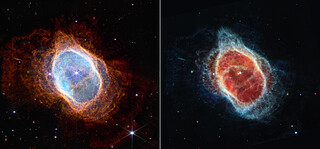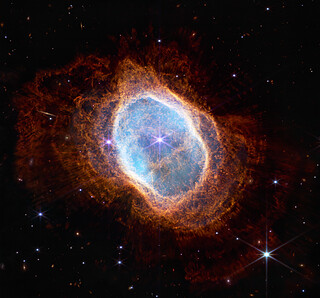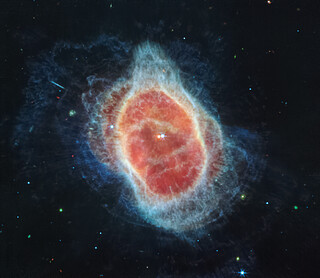weic2207 — Photo Release
Webb Captures Dying Star’s Final ‘Performance’ in Fine Detail
12 July 2022
The NASA/ESA/CSA James Webb Space Telescope has revealed details of the Southern Ring planetary nebula that were previously hidden from astronomers. Planetary nebulae are the shells of gas and dust ejected from dying stars. Webb’s powerful infrared view brings this nebula’s second star into full view, along with exceptional structures created as the stars shape the gas and dust around them. New details like these, from the late stages of a star’s life, will help us better understand how stars evolve and transform their environments. These images also reveal a cache of distant galaxies in the background. Most of the multi-coloured points of light seen here are galaxies — not stars.
Some stars save the best for last.
The dimmer star at the centre of this scene has been sending out rings of gas and dust in all directions for thousands of years, and the NASA/ESA/CSA James Webb Space Telescope has revealed for the first time that this star is cloaked in dust.
Two cameras aboard Webb captured the latest image of this planetary nebula, catalogued as NGC 3132 and known informally as the Southern Ring Nebula. It is approximately 2500 light-years away.
Webb will allow astronomers to dig into many more specifics about planetary nebulae like this one — clouds of gas and dust expelled by dying stars. Understanding which molecules are present, and where they lie throughout the shells of gas and dust, will help researchers refine their knowledge of these objects.
This observation shows the Southern Ring Nebula almost face-on. If we could rotate it to view it edge-on, its three-dimensional shape would look more like two bowls placed together at the bottom, opening away from one another with a large hole at the centre.
Two stars, which are locked together in a tight orbit, shape the local landscape. Webb's infrared images feature new details in this complex system. The stars — and their layers of light — are prominent in the image from Webb’s Near-Infrared Camera (NIRCam) on the left, while the image from Webb’s Mid-Infrared Instrument (MIRI) on the right shows for the first time that the second star is surrounded by dust. The brighter star is at an earlier stage of its evolution and will probably eject its own planetary nebula in the future.
In the meantime, the brighter star influences the nebula’s appearance. As the pair continues to orbit one another, they ‘stir the pot’ of gas and dust, causing asymmetrical patterns.
Each shell represents an episode during which the fainter star lost some of its mass. The widest shells of gas toward the outer areas of the image were ejected earlier. Those closest to the star are the most recent. Tracing these ejections allows researchers to look into the history of the system.
Observations taken with NIRCam also reveal extremely fine rays of light around the planetary nebula. Starlight from the central stars streams out where there are holes in the gas and dust — like sunlight through gaps in a cloud.
Since planetary nebulae exist for tens of thousands of years, observing a nebula is like watching a movie in exceptionally slow motion. Each shell the star puffed off gives researchers the ability to precisely measure the gas and dust that are present within it.
As the star ejects shells of material, dust and molecules form within them — changing the landscape even as the star continues to expel material. This dust will eventually enrich the areas around it, expanding into what’s known as the interstellar medium. And since it’s very long-lived, the dust may end up travelling through space for billions of years and become incorporated into a new star or planet.
In thousands of years, these delicate layers of gas and dust will dissipate into surrounding space.
More information
Webb is the largest, most powerful telescope ever launched into space. Under an international collaboration agreement, ESA provided the telescope’s launch service, using the Ariane 5 launch vehicle. Working with partners, ESA was responsible for the development and qualification of Ariane 5 adaptations for the Webb mission and for the procurement of the launch service by Arianespace. ESA also provided the workhorse spectrograph NIRSpec and 50% of the mid-infrared instrument MIRI, which was designed and built by a consortium of nationally funded European Institutes (The MIRI European Consortium) in partnership with JPL and the University of Arizona.
Webb is an international partnership between NASA, ESA and the Canadian Space Agency (CSA).
Image Credit: NASA, ESA, CSA, STScI, and the Webb ERO Production Team
Links
- Collection of Webb’s First Images
- Webb Fact Sheet
- ESA Webb Seeing Farther Interactive Brochure
- MIRI Fact Sheet
- Webb's European Partners
- Release on NASA website
- Release on ESA website
- Release on STScI website
- Release on CSA website
Contacts
Bethany Downer
ESA/Webb Chief Science Communications Officer
Email: [email protected]
Ninja Menning
ESA Newsroom and Media Relations Office
Email: [email protected]
About the Release
| Release No.: | weic2207 | |
|---|---|---|










